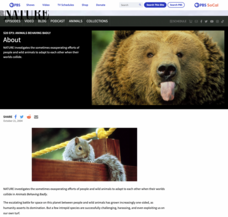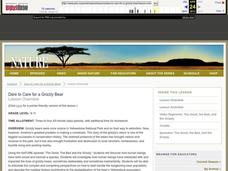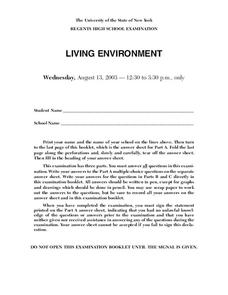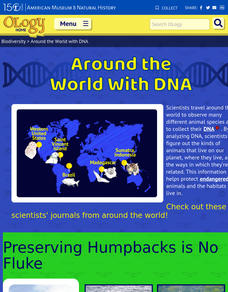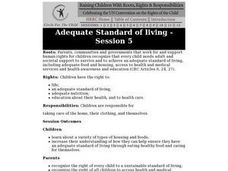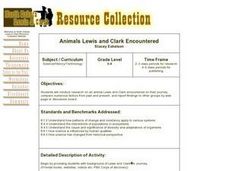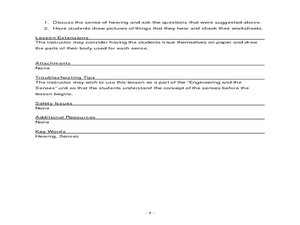LABScI
Population Dynamics: The Predator-Prey Lab
Wolves eat better when the bunny population increases, but how long does that last? A series of 12 biology lessons uses the sixth installment to explore the predator-prey relationship between bunny and wolf populations. Young scientists...
Howard Hughes Medical Institute
EarthViewer
Can you imagine Washington DC and London as close neighbors occupying the same continent? Learners will be fascinated as they step back in time and discover the evolution of the earth's continents and oceans from 4.5 billion...
Curated OER
Explorit's Bone Quiz
In this bones worksheet, students complete a ten question short answer quiz about human and animal bones. Students answer each question and self check. It appears that this is an online interactive worksheet.
Curated OER
Animals and People: Who's Behaving Badly?
Students explore the relationship between human beings and animals. They participate in a variety of activities to examine animal behavior. Students create a class book and stage a mock news broadcast.
Curated OER
Flora and Fauna of the Hill Neighborhood
Students compare and contrast the characteristics of plants and animals. In this ecology lesson, students observe the outdoors and describe the relationship among different living things. They relate plant diversity with animal diversity.
Curated OER
Not Just A Bag of Air
Fifth graders label the parts of the respiratory system. They distinguish among the functions of its major organs. They construct a model of the respiratory system. They watch an animated video and utilize the Internet for research of...
Curated OER
Stem Cells: 5 Year Progress Report
Students explore different aspects of stem cells. In this human biology activity, students complete numerous activities including reading an article and discussing it, watching a video on stem cells reproducing over time, and...
Curated OER
Dare to Care for a Grizzly Bear
Students examine the relationship between humans and grizzly bears. In this biology lesson, students research about the bear's habits and living environment. They write a letter to the US Fish and Wildlife Service petitioning them to...
Curated OER
Something Fishy Going On
Students create a video animation of how Swimmy gathered his fish friends together to form a great big fish that would frighten the predator tuna away. In art class each child create a small red fish which gets displayed in the ocean...
Curated OER
Elephants
In this elephants interactive worksheet, students read short passages of information about elephants before answering 10 multiple choice questions. They check their answers and start again if needed.
Curated OER
Amazing Grazing: Keeping Our Ecosystem Running
Students discover the value of sustainability within our ecosystem. In this ecological instructional activity, students discuss the importance of a food cycle in our society, and how humans can improve the conservation of a healthy...
Curated OER
Living Environment
For this environmental lesson students complete a series of multiple choice and short answer questions on animal populations, cell structure and chromosomes.
Sea World
Ocean Discovery
Immerse your young marine biologists in the world of marine animals. The activity includes several activities that are age-appropriate for preschoolers and kindergartners, including coloring pages, gluing feathers and sand onto paper...
American Museum of Natural History
Around with World with DNA
A mammalogist, ornithologist, ichthyologist, and a conservation geneticist share their work and their hopes that their research will help protect and save endangered species and their habitats.
Curated OER
Endangered!
Students research endangered species. In this ecology and literacy research lesson, students work with a partner to research an endangered species of their choice. Students choose from a variety of presentation methods and...
Curated OER
Adequate Standard of Living: Children's Rights
Pupils and parents participate in a variety of activities designed to explore the issue of every person's right to adequate housing. They make butter, make models of different types of housing, read books, discuss the rights and...
Curated OER
Students Solutions - Saving Our Surroundings
Students explore the environmental impact of humans on the plants and animals in their state. In this environmental impact lesson, students use digital cameras to photograph plants and animals in their state. Students investigate the...
Curated OER
Animals Lewis and Clark Encountered
Students conduct research on an animal Lewis and Clark encountered on their journey, compare numerous factors from past and present, and report findings to other groups by web page or discussion board.
Curated OER
Double Trouble?
Learners investigate cloned meat and animal products. In this food safety lesson, students research the noted Web sites in search of information about cloning and food labelling. Learners use their findings to create informative...
Curated OER
Frog Metamorphosis
Students play 20 Questions with animal characteristics and then view an animation of how a tadpole changes into a frog. They consider the importance of camouflage to frogs and write out the story of a frog from tadpole to adult.
Curated OER
Engineering and the Senses: Hearing
Students explore the sense of hearing. For this 5 senses lesson, students consider how humans and animals use the sense of hearing along with their other senses. Students discuss the body parts responsible for the 5 senses and...
Curated OER
Stimulus Response
Middle schoolers explore the five steps in the stimulus-response pathway. They analyze the senses and the difference between animals' primary and secondary senses. Students collect information about animal behavior to debate the ethics...
Curated OER
Title: Biodiversity Analysis and Comparison Within the New Jersey Highlands
Students explore the concept of biodiversity. In this environmental science lesson, students use field methods to examine the trophic relationship that allows for species diversity.
Curated OER
Radical Raptors
Students are introduced to raptors and their role in the environment. They identify three characteristics of raptors and list several types of raptors found in nature. Students discuss how raptors and humans can benefit each other and...



